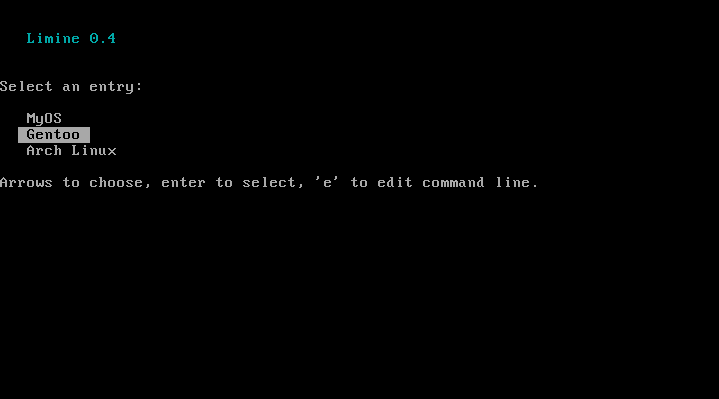Limine
x86/x86_64 BIOS Bootloader
Supported boot protocols
- Linux
- stivale and stivale2 (Limine's native boot protocols, see STIVALE{,2}.md for details)
Supported filesystems
- ext2
- echfs
- FAT32
Supported partitioning schemes
- MBR
- GPT
Building
Dependencies
To build Limine, it is necessary to have an LLVM/Clang toolchain installed.
More specifically, the following programs need to be present: clang, llvm-objcopy,
llvm-link, opt, ld.lld.
Furthermore, nasm also needs to be installed.
curl, tar, and zstd need to be installed for retrieving libgcc.a during build.
Compiling
A simple make and make install will suffice. Use the PREFIX variable with
make install to specify where to install limine-install. It defaults to
/usr/local.
How to use
In order to install Limine on a MBR device (which can just be a raw image file),
run the limine-install as such:
limine-install <path to device/image>
If using a GPT formatted device, it will be necessary to create an extra partition
(of at least 32K in size) to store stage 2 code. Then it will be necessary to tell
limine-install where this partition is located by specifying the start sector.
fdisk <device> # Create bootloader partition using your favourite method
limine-install <path to device/image> <start sector of boot partition>
Then make sure the device/image contains at least 1 partition formatted in
a supported filesystem containing a /limine.cfg or /boot/limine.cfg file
and the kernel/modules one wants to load.
An example limine.cfg file can be found in test/limine.cfg.
More info on the format of limine.cfg can be found in CONFIG.md.
For example, to create an empty image file of 64MiB in size, 1 echfs partition on the image spanning the whole device, format it, copy the relevant files over, and install Limine, one can do:
dd if=/dev/zero bs=1M count=0 seek=64 of=test.img
parted -s test.img mklabel msdos
parted -s test.img mkpart primary 1 100%
parted -s test.img set 1 boot on # Workaround for buggy BIOSes
echfs-utils -m -p0 test.img quick-format 32768
echfs-utils -m -p0 test.img import path/to/limine.cfg limine.cfg
echfs-utils -m -p0 test.img import path/to/kernel.elf kernel.elf
echfs-utils -m -p0 test.img import <path to file> <path in image>
...
limine-install test.img
One can get echfs-utils by installing https://github.com/qword-os/echfs.
Limine uses a stripped-down version of https://github.com/jibsen/tinf
Discord server
We have a Discord server if you need support, info, or you just want to hang out: https://discord.gg/QEeZMz4
